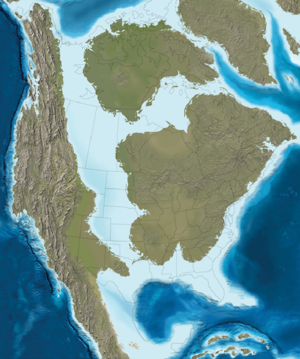Blood Reserve Formation facts for kids
Quick facts for kids Blood Reserve FormationStratigraphic range: Campanian ~73–76Ma |
|
|---|---|
| Type | Geological formation |
| Underlies | St. Mary River Formation |
| Overlies | Bearpaw Formation |
| Thickness | up to 30 metres (100 ft) |
| Lithology | |
| Primary | Sandstone |
| Location | |
| Coordinates | 49°29′N 112°59′W / 49.48°N 112.99°W |
| Region | |
| Country | |
| Type section | |
| Named for | Blood Indian Reserve No. 148 |
| Named by | L.S. Russell |
| Year defined | 1932 |
The Blood Reserve Formation is a special layer of rock, also called the Blood Reserve Sandstone. It formed a very long time ago, during the Late Cretaceous period. This was about 73 to 76 million years ago! You can find it in southwestern Alberta, Canada. It was named in 1932 after the Blood Indian Reserve No. 148. This rock layer is important because it holds fresh groundwater, acting like a natural underground water storage!
Contents
What is the Blood Reserve Formation Made Of?
The Blood Reserve Formation is mostly made of hard sandstone. This sandstone often forms cliffs. The rock can be light grey to grey-buff when freshly broken. Over time, it changes to buff, yellow, or greenish colors.
How it Formed
The sand grains in this rock are held together by calcite (like in seashells) and tiny clay minerals. You can often see interesting patterns in the rock. These include "cross-bedding," which looks like slanted layers. This happens when sand is moved by water or wind. There are also round, hard lumps called "concretions" made of calcite.
In the lower parts of the formation, you might find special burrows. These are called Ophiomorpha burrows. They were made by ancient shrimp-like creatures digging in the sand.
Ancient Environment
Scientists believe the Blood Reserve sandstones formed along ancient shorelines. This means the area was once a coast with beaches and barrier islands. It also had "tidal inlets," which are narrow channels where ocean water flows in and out with the tides. Imagine a sandy beach environment, but millions of years ago!
Where is the Blood Reserve Formation Found?
The Blood Reserve Formation can be seen on the surface in a narrow strip of land. This strip stretches from the Canada–United States border northwards. Near the border, this rock layer is about 30 meters (100 feet) thick. As you go north towards the Oldman River, it becomes thinner, about 12 meters (40 feet) thick.
This rock layer also extends underground. It dips down towards the west, so you can find it deeper below the surface in areas west of where it appears on the ground.
How it Connects to Other Rock Layers
Think of rock layers like a stack of pancakes. The Blood Reserve Formation sits directly on top of another rock layer called the Bearpaw Formation. The Bearpaw Formation is made of marine shales and siltstones. This means it formed in the ocean.
Above the Blood Reserve Formation is the St. Mary River Formation. This layer formed from ancient floodplains, like river banks and muddy areas. The connections between these layers are very clear and distinct.
The Blood Reserve Formation is also linked to other rock layers in different areas. For example, it's similar to the Horsethief Sandstone found in northern Montana. It also matches parts of the Bearpaw Formation in the Cypress Hills and the lower part of the Horseshoe Canyon Formation further north in Alberta.
Ancient Life: Trace Fossils
While we don't find dinosaur bones directly in the Blood Reserve Formation, we do find "trace fossils". These are not parts of ancient animals themselves, but rather signs of their activities.
Some trace fossils found here include:
- Ophiomorpha burrows: As mentioned, these are tunnels made by ancient shrimp or similar creatures.
- Fossil wood with Teredolites borings: These are holes found in ancient wood. They were made by shipworms, which are a type of clam that drills into wood.
- Rare Macaronichnus burrows: These are another type of burrow, likely made by worms or similar soft-bodied creatures.
These trace fossils help scientists understand what kind of life existed in this ancient shoreline environment millions of years ago!


